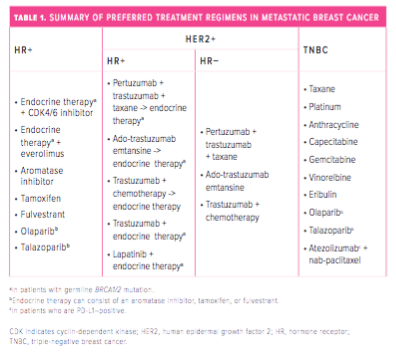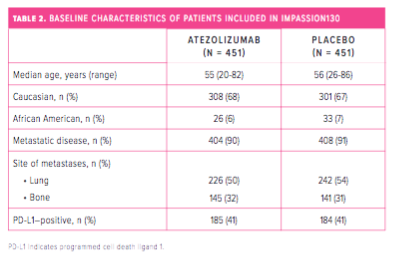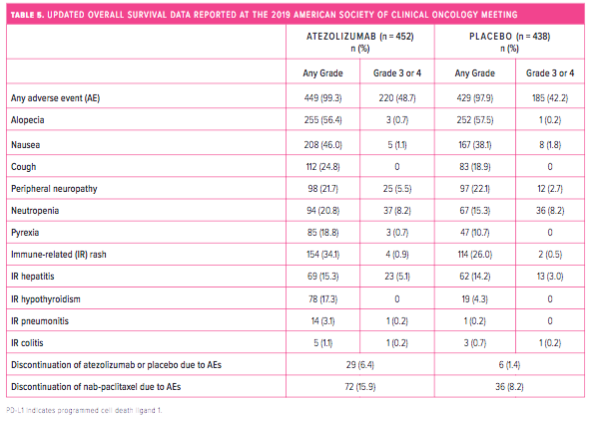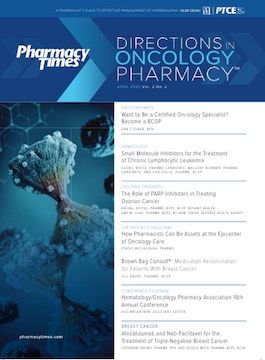Publication
Article
Pharmacy Practice in Focus: Oncology
Atezolizumab and Nab-Paclitaxel for the Treatment of Triple-Negative Breast Cancer
Compared with other breast cancer subtypes, TNBC is more likely to be diagnosed in younger women and is more likely to have metastases present at the time of diagnosis.
BREAST CANCER IS the most common cancer diagnosed in women, and it is estimated that 1 in 8 females in the United States will be diagnosed during their lifetime.1 Each year, the American Cancer Society estimates the numbers of new cancer cases and deaths that will occur in the United States and compiles the most recent data on cancer incidence, mortality, and survival. Incidence data, available through 2015, were collected by the Surveillance, Epidemiology, and End Results Program; the National Program of Cancer Registries; and the North American Association of Central Cancer Registries. Mortality data, available through 2016, were collected by the National Center for Health Statistics. In 2019, 1,762,450 new cancer cases and 606,880 cancer deaths are projected to occur in the United States.
Breast cancer is classified into 3 subtypes: hormone receptor (HR)-positive, human epidermal growth factor 2 (HER2)-positive, and triple-negative breast cancer (TNBC).2 TNBC represents 10% to 15% of breast cancer cases and is diagnosed when patients are HR-negative (ie, both estrogen receptor— and progesterone receptor–negative) and HER2-negative.2,3 Compared with other breast cancer subtypes, TNBC is more likely to be diagnosed in younger women and is more likely to have metastases present at the time of diagnosis.2 Unfortunately, patients with metastatic TNBC have a median overall survival (OS) of roughly 1 year, compared with approximately 5 years in patients with metastatic HR-positive or HER2-positive disease.2 This is partly due to a more aggressive disease course as well as a lack of targeted therapy options in TNBC treatment.3
Treatment Strategies for Metastatic Breast Cancer
Until recently, conventional chemotherapy remained the only option in treating metastatic TNBC,3,4 whereas targeted treatment options exist for the other subtypes of breast cancer (Table 1).2,5,6 In general, the treatment of metastatic TNBC consists of sequential single-agent cytotoxic chemotherapy with a taxane, platinum, or anthracycline agent.2 Of note, platinum agents may be particularly beneficial in patients with a BRCA mutation.7 Compared with combination chemotherapy, sequential single-agent chemotherapy for metastatic TNBC resulted in similar outcomes with fewer adverse events.2 Additional recommended options include vinorelbine, eribulin, capecitabine, and gemcitabine.2 Several targeted agents have been studied in this population, so far without much success.

Cetuximab, an epidermal growth factor receptor inhibitor, has been studied in combination with chemotherapy in metastatic TNBC. Although the addition of cetuximab did result in longer progression-free survival (PFS), there was no difference in OS.8 Similarly, when the vascular endothelial growth factor inhibitor bevacizumab was studied in this patient population, the drug improved PFS but not OS.9 Most recently, olaparib and talazoparib, poly ADP-ribose polymerase inhibitors, proved to be beneficial in patients with TNBC with germline BRCA 1/2 mutations.10,11They do provide an alternative to conventional chemotherapy but are indicated only in a small portion of patients.2
Combination of Atezolizumab and Nab-Paclitaxel
Nab-paclitaxel (Abraxane; Celgene), a protein-bound formulation of paclitaxel, inhibits cell replication by preventing disassembly of microtubules. Compared with conventional paclitaxel, nab-paclitaxel has a decreased risk of hypersensitivity reactions and does not require corticoste-roid pretreatment.12 Atezolizumab (Tecentriq; Genentech), an immune checkpoint inhibitor, exerts its effects by binding to programmed cell death ligand 1 (PD-L1) to prevent activation of programmed cell death protein 1.13 It is approved for the treatment of certain patients with locally advanced or metastatic urothelial carcinoma, extensive-stage small cell lung cancer, and metastatic non—small cell lung cancer.13 In March 2019, it was also approved in combination with nab-paclitaxel for treatment of metastatic or locally advanced unresectable TNBC in patients with PD-L1 expression on tumor-infiltrating immune cells. Atezolizumab is thus the first immunotherapy approved for TNBC. The approval came after the IMpassion130 trial demonstrated an OS benefit in this patient population.14
IMpassion130 was a randomized, double-blind, placebo-controlled, phase 3 trial. Patients were eligible if they were 18 years or older, had metastatic or unresectable locally advanced TNBC, and had not received any previous chemotherapy or targeted therapy for metastatic TNBC. Patients were excluded if they had untreated central nervous system disease, a history of autoimmune disease, recent use of a systemic immunostimulatory agent, or current use of systemic glucocorticoids or immunosuppressants. Patients were randomized to receive either atezolizumab 840 mg intravenously on days 1 and 15 in combination with nab-paclitaxel 100 mg/m2 on days 1, 8, and 15 of every 21-day cycle, or nab-paclitaxel monotherapy (with placebo). Nab-paclitaxel was used to avoid the interaction between atezolizumab and corticosteroids. The primary end points were PFS and OS. Secondary end points included the rate and duration of objective response and safety outcomes.14
A total of 902 patients were included in the study, with 451 randomized to each treatment arm. Baseline characteristics were similar between the 2 groups (Table 2). In each group, 41% of patients were PD-L1—positive, defined as having ≥1% PD-L1 expression on tumor-infiltrating immune cells.14 PFS was significantly longer in patients treated with atezolizumab and nab-paclitaxel compared with nab-paclitaxel alone (7.2 vs 5.5 months; hazard ratio, 0.81; 95% CI, 0.7-0.93). This benefit was seen in the intention-to-treat population as well as in the PD-L1—positive subgroup (Table 3). There was no significant difference in OS between the 2 groups in the intention-to-treat population(21.3 vs 17.6 months; hazard ratio, 0.84; 95% CI, 0.69-1.02). However, in the PD-L1–positive subgroup, the median OS was 9.5 months longer in the atezolizumab/nab-paclitaxel group compared with the nab-paclitaxel monotherapy group (25.0 vs 15.5 months; hazard ratio, 0.62; 95% CI, 0.45-0.86).14


An updated OS analysis was presented at the 2019 American Society of Clinical Oncology meeting (Table 4). Still, no significant difference in OS was seen in the intention-to-treat population. In the PD-L1—positive subgroup, median OS was still significantly longer in the atezolizumab arm, but the difference was 7 months instead of the 9.5 months originally published (25.0 vs 18.0 months; hazard ratio, 0.71; 95% CI, 0.54-0.93).15

Nearly all patients included in the safety analysis experienced at least 1 adverse event (AE) (Table 5). Common AEs in both groups included alopecia, nausea, cough, peripheral neuropathy, neutropenia, and pyrexia. As in other populations treated with other immune checkpoint inhibitors, immune-related AEs (irAEs) were common. The most common irAEs included rash, hepatitis, hypothyroidism, pneumonitis, and colitis. Although 1 death was attributed to autoimmune hepatitis, most of the irAEs were classified as grade 1 or 2.14
Excluding irAEs, the incidence of AEs was similar between the 2 groups. However, in the atezoli-zumab group, a larger proportion of patients discontinued both nab-paclitaxel and atezolizumab compared with the nab-paclitaxel monotherapy group (Table 5).

Conclusions
TNBC represents a subset of patients with breast cancer with poor prognosis and few treatment options. Atezolizumab, in combination with nab-paclitaxel, is the first immunotherapy approved in TNBC and the first agent, other than conventional chemotherapy, to show an OS benefit. It is important to remember that it holds an approval only for TNBC patients with metastatic or locally advanced disease who are PD-L1—positive. The findings of the IMpassion130 trial are a reason for optimism in this patient population, but irAEs are common and require vigilant monitoring.
CATHERINE DEFINO, PHARMD, RPH, is a resident in PGY-1 Pharmacy Residency at Mayo Eugenio Litta Children's Hospital.JESSICA MUTH, PHARMD, BCPS, BCOP, is assistant program director in PGY-2 Pharmacy Residency in Oncology at Mayo Clinic Hospital.
REFERENCES
- Siegel RL, Miller KD, Jemal A. Cancer statistics, 2019. CA Cancer J Clin. 2019;69(1):7-34. doi: 10.3322/caac.21551.
- Waks AG, Winer EP. Breast cancer treatment: a review. JAMA. 2019;321(3):288-300. doi: 10.1001/jama.2018.19323.
- Tong CWS, Wu M, Cho WCS, To KKW. Recent advances in the treatment of breast cancer. Front Oncol. 2018;8:227. doi: 10.3389/fonc.2018.00227.
- Foulkes WD, Smith IE, Reis-Filho JS. Triple-negative breast cancer. N Engl J Med. 2010;363(20):1938-1948. doi: 10.1056/NEJMra1001389.
- Harbeck N, Gnant M. Breast cancer. Lancet. 2017;389(10074):1134-1150. doi: 10.1016/S0140-6736(16)31891-8.
- Figueroa-Magalhães MC, Jelovac D, Connolly R, Wolff AC. Treatment of HER2-positive breast cancer. Breast. 2014;23(2):128-136. doi: 10.1016/J.BREAST.2013.11.011.
- Tutt A, Ellis P, Kilburn L, et al. The TNT trial: a randomized phase III trial of carboplatin compared with docetaxel for patients with metastatic or recurrent locally advanced triple negative or BRCA1/2 breast cancer. Abstract S3-01. Presented at: San Antonio Breast Cancer Symposium; December 9-13, 2014; San Antonio, TX.doi: 10.1158/1538-7445.SABCS14-S3-01.
- Baselga J, Gómez P, Greil R, et al. Randomized phase II study of the anti—epidermal growth factor receptor monoclonal antibody cetuximab with cisplatin versus cisplatin alone in patients with metastatic triple-negative breast cancer. J Clin Oncol. 2013;31(20):2586-2592. doi: 10.1200/JCO.2012.46.2408.
- Miles DW, Diéras V, Cortés J, Duenne A-A, Yi J, O’Shaughnessy J. First-line bevacizumab in combination with chemotherapy for HER2-negative metastatic breast cancer: pooled and subgroup analyses of data from 2447 patients. Ann Oncol. 2013;24(11):2773-2780. doi: 10.1093/annonc/mdt276.
- Robson M, Im S-A, Senkus E, et al. Olaparib for metastatic breast cancer in patients with a germline BRCA mutation. N Engl J Med. 2017;377(6):523-533. doi: 10.1056/NEJMoa1706450.
- Litton JK, Rugo HS, Ettl J, et al. Talazoparib in patients with advanced breast cancer and a germline BRCA mutation. N Engl J Med. 2018;379(8):753-763. doi: 10.1056/NEJMoa1802905.
- Abraxane (paclitaxel protein bound) [prescribing information]. Summit, NJ: Celgene Corporation; 2018. xxx.
- Tecentriq (atezolizumab) [prescribing information]. South San Francisco, CA: Genentech Inc; 2019. xxx.
- Schmid P, Adams S, Rugo HS, et al; IMpassion 130 Trial Investigators. Atezolizumab and nab-paclitaxel in advanced triple-negative breast cancer. N Engl J Med. 2018;379(22):2108-2121. doi: 10.1056/NEJMoa1809615.
- Schmid P, Adams S, Rugo HS, et al. IMpassion130: updated overall survival from a global, randomized, double-blind, placebo-controlled, phase III study of atezolizumab + nab-paclitaxel in previously untreated locally advanced or metastatic triple-negative breast cancer. J Clin Oncol. 2019;37(15_suppl; abstr 1003). doi: 10.1200/JCO.2019.37.15_suppl.1003.







